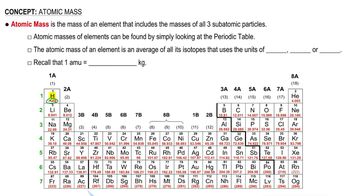The molecular weight of a compound is the sum of the atomic masses of all atoms in the molecule. What is the molecular mass of acetaminophen (C8H9NO2), the active ingredient in Tylenol?
 Verified step by step guidance
Verified step by step guidance
Verified video answer for a similar problem:
Key Concepts
Molecular Weight

Atomic Mass

Chemical Formula

In an alternate universe, the smallest negatively charged particle, analogous to our electron, is called a blorvek. To determine the charge on a single blorvek, an experiment like Millikan's with charged oil droplets was carried out, and the following results were recorded : (a) Based on these observations, what is the largest possible value for the charge on a blorvek?
In an alternate universe, the smallest negatively charged particle, analogous to our electron, is called a blorvek. To determine the charge on a single blorvek, an experiment like Millikan's with charged oil droplets was carried out, and the following results were recorded : (b) Further experiments found a droplet with a charge of 5.81 * 10-16 C. Does this new result change your answer to part (a)? If so, what is the new largest value for the blorvek's charge?
